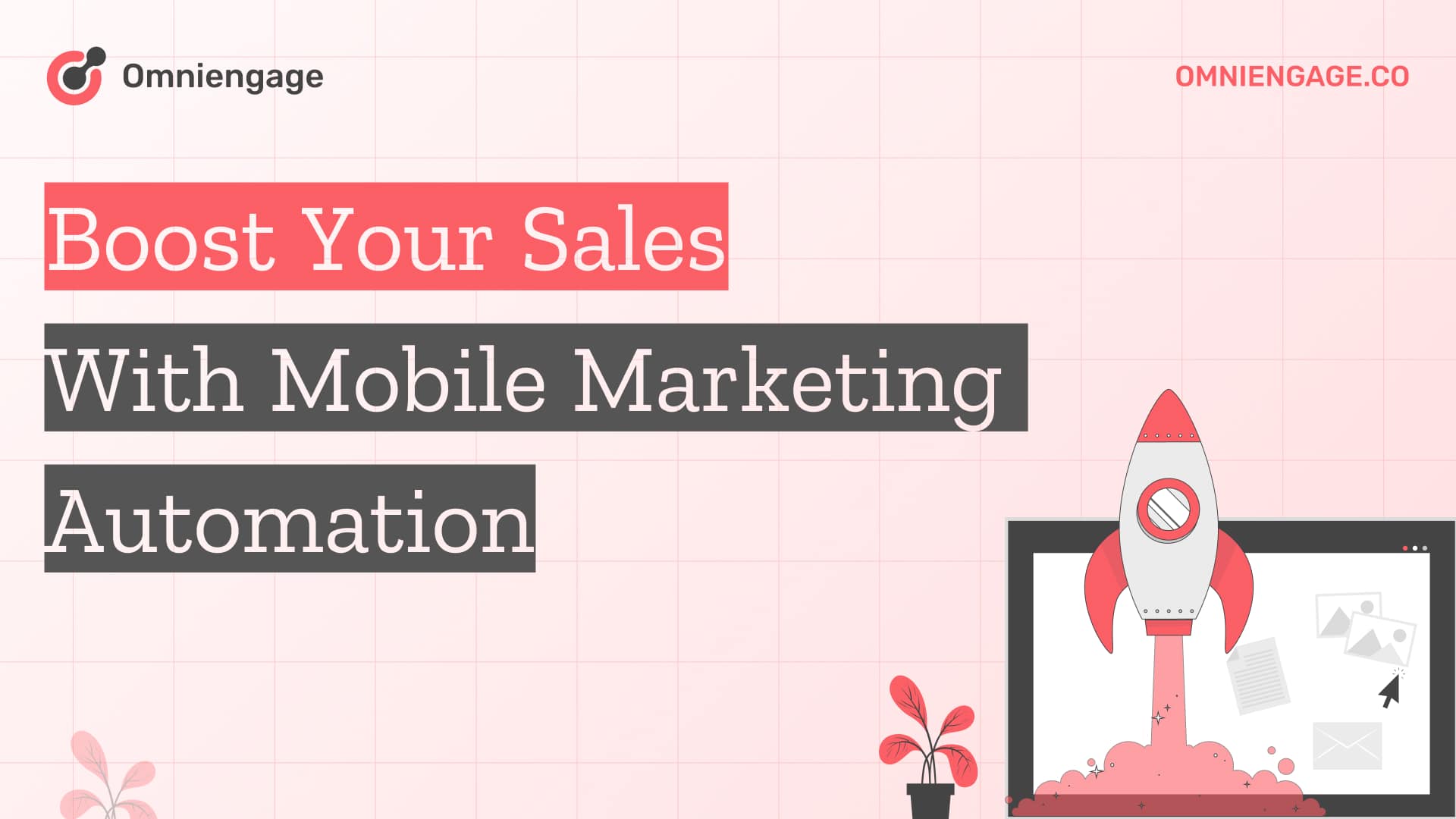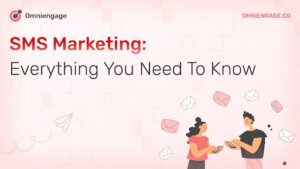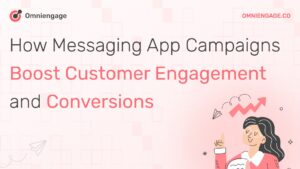For companies looking to leverage mobile marketing, having a mobile app ensures increased customer engagement and helps to drive sales. Omnichannel commerce has expanded beyond its offline roots to encompass social platforms and digital marketplaces online. And guess what? Mobile devices are the crucial bridge to a complete digital presence for your business. It’s about being there, in their pocket, notifying them about that deal or update they just can’t miss. Why? Because that’s where they’re at — glued to their smartphones. With mobile marketing automation, companies large and small can cost-effectively nurture customer relationships, drive conversions, increase lifetime value and scale.
What is Mobile Marketing Automation?
Mobile marketing automation tools streamline the process of connecting across multiple consumer touchpoints. A mobile can automate sending relevant push notifications, in-app messages, SMS, emails and more, based on each individual’s preferences and behaviors. This personalization helps ensure messaging resonates with and delights your customers.
Definition of Mobile Marketing Automation
Mobile marketing refers to any marketing activity that targets users on mobile devices, while mobile marketing automation focuses on using software and technology to automate and streamline mobile marketing tasks.
Here are some captivating ways mobile marketing automation helps to reach customers across channels and distribute content that is most relevant to them, seamlessly:

- Reach customers where they are – Mobile opens new opportunities to connect with customers on the devices they always have with them. This allows for more convenient, customized interactions.
- Enable faster purchases – With mobile wallet integration and progressive web apps that facilitate seamless transactions, you make it easier for customers to purchase on the spot.
- Strengthen customer relationships – Location-based notifications, exclusive mobile promotions and social messaging campaigns foster ongoing dialogues with customers that deepen engagement.
- Drive loyalty – Personalized offers sent right when a customer is nearby help you provide relevant, timely incentives that encourage regular business and repeat purchases to build customer loyalty.
- Get actionable insights – Tracking customer response to mobile campaigns provides valuable data on how to tailor communications to match their preferences and get better results.
- Design mobile-first social media advertising: Craft eye-catching ad campaigns for mobile users, as the majority of social media platform users access them via mobile devices.
- Enhance the shopping experience with interactive content: Incorporate augmented reality or add fun quizzes to engage users on app benefits. Use virtual try-ons and interactive product experiences.
- Experiment with mobile video marketing: Create engaging video content optimized for mobile viewing to boost brand awareness and increase conversions.
How Does Mobile Marketing Automation Work?
Mobile marketing automation is like having a smart digital assistant for your business that streamlines your outreach efforts with precision and style. Imagine your mobile platform working behind the scenes to send timely push notifications, in-app messages, and personalized emails. By seamlessly integrating various communication channels like SMS, push notifications, and in-app messages, your marketing strategy becomes a symphony of connectivity, reaching your audience wherever they are.
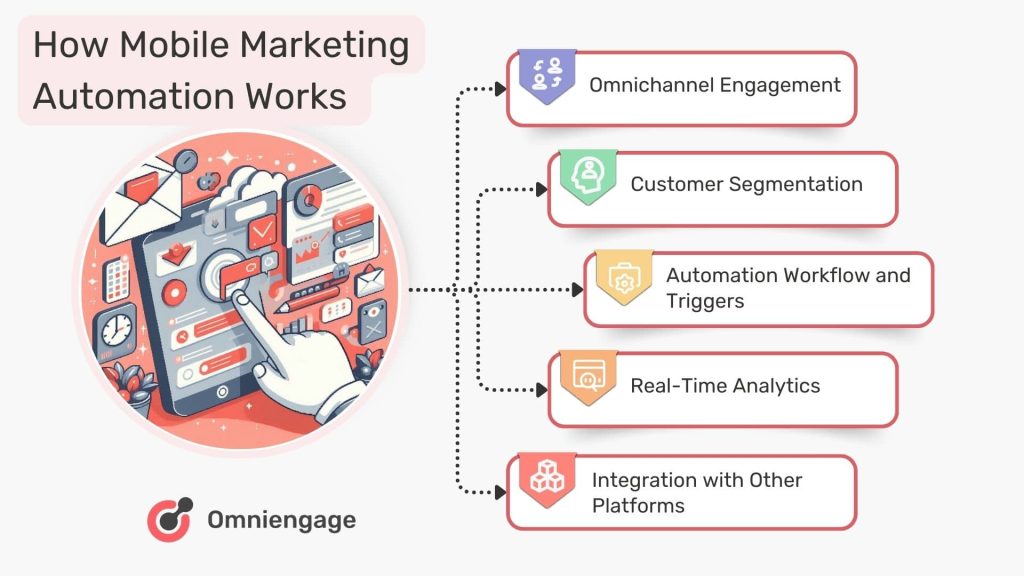
Omnichannel Engagement
A mobile can automate sending relevant push notifications, in-app messages, emails and more, based on each individual’s preferences and behaviors. It integrates various channels to provide a unified customer experience. It’s about ensuring your brand shows up in a cohesive, engaging way across all the mobile channels your customers love. By sending messages that feel personal and perfectly timed, you’re not just reaching out; you’re resonating, making every touchpoint matter.
Customer Segmentation
Encouraging users to create profiles within your mobile app opens doors to many customization possibilities. Gathering information on mobile device usage, preferences, and interactions allows you to adapt the user interface, offer personalized notifications, and deliver mobile-specific content. This level of personalization creates a deeper connection with users, fostering long-term engagement and loyalty.
Automation Workflows and Triggers
Mobile marketing automation workflows are vital for engaging customers at key touchpoints. These workflows can be initiated by user actions, events, or predicted behavior. Let’s explore examples of automation scenarios and their related triggers:
User-based automation:
- Welcome series: When a new user joins your app, welcome them with a series of messages introducing app features and offering personalized recommendations based on preferences.
- Onboarding sequence: Guide users through setting up their profile and customizing preferences to boost engagement.
- Loyalty program enrollment: Automatically enroll users in your loyalty program when they hit specific milestones like making purchases or accumulating points.
Event-based automation:
- Abandoned cart reminder: Prompt users who left items in their cart to complete the purchase with personalized reminders.
- Location-based offers: Send targeted notifications with special deals when users enter specific geofenced areas.
- Post-purchase follow-up: Show appreciation after a purchase with thank you messages, feedback requests, and personalized product recommendations.
Prediction-based automation:
- Churn prevention: Re-engage users at risk of leaving by offering incentives or reminders of your app’s value.
- Upsell or cross-sell recommendations: Suggest higher-tier products or complementary items based on user behavior.
- Personalized content recommendations: Recommend tailored content to increase user engagement.
Imagine this scenario: A user abandons running shoes in their cart. After 30 minutes, send a push notification urging them to complete the purchase for free shipping. If they don’t buy within 24 hours, offer a discount code via email. Upon completing the purchase, extend gratitude and suggest related accessories. This way your business can not only re-engage customers preventing churn but also gather important feedback and generate referrals.
Analytics
To provide customized experiences, monitoring how users interact with the app is essential. By analyzing how users navigate, what they search for, and what content they engage with, you gain valuable insights to give recommendations and guide them to relevant product pages. This improves their overall experience with the app and keeps users hooked.
Furthermore, AI also empowers businesses to analyze complex data, detecting patterns that optimize dynamic pricing, inventory, marketing strategies and more. Now there are tools that boost customer centric marketing to understand customers on an individual level and cater to their preferences through customized messaging and product recommendations. Useful AI chatbots and virtual assistants enrich the shopping journey by promptly answering questions and guiding users to relevant items.
Integration with Other Systems
If you’re a business owner or an ecommerce enthusiast, you know how important it is to optimize your mobile delivery and marketing automation. For this you need proper integration with tools that can help you save time, improve efficiency, and boost your conversion rates.
- First up, there’s the Customer Relationship Management (CRM) system. It allows you to create personalized messages, targeted segments, and relevant offers based on individual customer profiles. This way, you can make sure you’re reaching the right people with the right content.
- Next, there’s Mobile Analytics and Attribution platforms. Essential to integration in order for you to get insights into user behavior, app performance, and campaign effectiveness. You can use these insights to identify which channels are working best for you and which touchpoints are driving the most conversions.
- Another powerful tool is Push Notification Services. By integrating with push services like Firebase, you can send tailored, timely push notifications to users’ devices. This keeps users engaged with your content, promotions, and updates even when they’re not actively using the app.
- Last but not least, there’s the E-commerce Platform for businesses equipped for mobile commerce. Integrating this platform, like Shopify, provides personalized product recommendations, reminders for abandoned carts, and post-purchase follow-ups. It also seamlessly synchronizes product catalogs, inventory, and order data.
Benefits of Mobile Marketing Automation
Ever feel like you’re juggling too many things? Imagine your brand doing that with mobile channels. Mobile marketing automation keeps channels super-organized to help everything run smoothly. It’s all about making sure your brand’s messages reach your customers through their favourite hangouts – whether that’s through a little nudge via push notifications, a friendly “Hey!” in an in-app message, or a sweet deal popping up in their mobile wallet (hello, Apple Wallet and Google Pay!).

Increased Customer Engagement
With the rise of social media, integrating social media into your apps can help increase your visibility and drive traffic. Businesses can incorporate social sharing options, enabling customers to share product reviews and experiences across multiple social media messaging apps. Social media can give you access to messaging apps that allow you to tap into customer needs at short notice. The vast potential of social commerce can drive immense growth.
Personalized Communication
Customers expect personalized experiences from brands. Personalized messages, offers, or discounts can target customers better and are proven ways to drive repeat purchases and increase revenue. Personalization and contextualization in mobile marketing are crucial for creating engaging and relevant customer experiences.
You can make your mobile app stand out by offering personalized user profiles and saved favourites. By allowing users to customize their experience to their preferences, they will be more invested in your app and enjoy using it even more.
Improved Customer Insights
Mobile marketing automation allows businesses to gain valuable insights by tracking customer behavior, preferences, and buying patterns across touchpoints. By utilizing mobile analytics, companies can refine their marketing strategies, develop pricing approaches that resonate with mobile users, and boost their ROI. By analyzing mobile user behavior, you can enhance conversion rates for a better overall mobile customer experience.
Higher Conversion Rates
By personalizing product recommendations, recovering abandoned carts, enabling seamless cross-device shopping, providing real-time updates, and simplifying checkout with one-click and mobile wallet integration, you can reduce friction in the buying journey and enhance customer satisfaction.
Time and Resource Efficiency
Mobile marketing automation streamlines campaign management to save time and resources. It reduces manual effort by using automated workflows, templates, and real-time optimization. A centralized platform for multiple channels improves management. Plus analytics provide insights for data-driven decisions, ensuring effective resource allocation. Ultimately, automation allows marketers to focus on strategy and creativity for better results.
Actionable Example to Boost Conversion Rates
Mobile marketing automation can improve the customer checkout process, increase conversions, and drive better returns on investment. By personalizing product recommendations, recovering abandoned carts, enabling seamless cross-device shopping, providing real-time updates, and simplifying checkout with one-click and mobile wallet integration, you can reduce friction in the buying journey and enhance customer satisfaction.
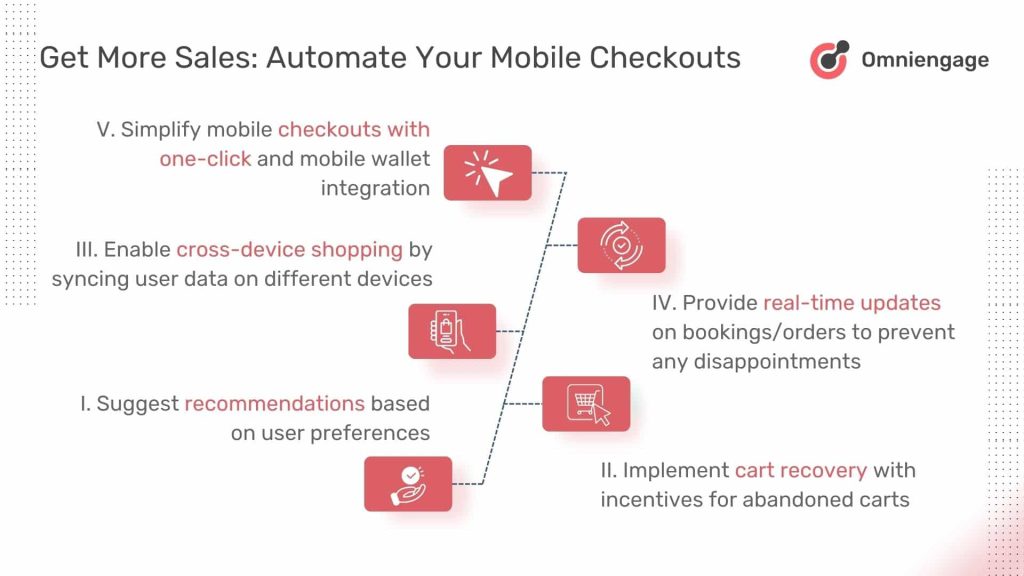
Let’s dive into how mobile marketing automation can enhance checkout process and boost the bottom line:
I. Suggest product recommendations based on user preferences
Marketing automation can provide personalized product recommendations for mobile shoppers based on their browsing behavior and preferences by tracking their interactions on the app or website.
II. Implement automated cart recovery with incentives for abandoned carts
Mobile marketing automation can be used by businesses to recover abandoned mobile carts. Personalized push notifications or emails with incentives can be sent to encourage users to complete their purchases.
III. Create a seamless shopping experience across devices
Have you ever been shopping on your phone and then switched to your desktop to complete the purchase, only to find your cart empty? Seamless switching between mobile and desktop devices can solve the problem. So that’s where mobile marketing automation comes in – it ensures a consistent experience across devices, making shopping a breeze!
IV. Provide real-time updates on bookings/orders to prevent any disappointments
Real-time updates inform customers about new product changes, out-of-stock items, appointments, availability of medical care, downtime, discounts, or deals. They help you maintain good relationships with customers and build trust in your brand.
V. Simplify mobile checkouts with one-click and mobile wallet integration
You can make your mobile checkout process a breeze to improve conversion rates. With one-click purchases and the convenience of mobile wallets, your customers will appreciate the friction-free experience.
How to Choose the Best Mobile Marketing Automation Platform
Choosing the best mobile marketing automation software can be a daunting task, as there are numerous options available in the market. Here are some key factors to consider when selecting the right platform for your business:

Features and Capabilities
- Evaluate the features offered by each platform, such as multi-channel campaign management, segmentation, personalization, A/B testing, and analytics.
- Ensure that the platform supports the mobile channels that are most relevant to your business, such as push notifications, in-app messaging, SMS, and mobile wallets.
- Look for platforms that offer advanced capabilities like real-time messaging, geofencing, and machine learning-based personalization.
Integration with Existing Systems
- Consider how well the mobile marketing automation platform integrates with your existing marketing tech stack, such as your CRM, email marketing platform, e-commerce platform, and analytics tools.
- Seamless integration ensures a smooth flow of data and a unified view of the customer journey across all touchpoints.
Ease of Use and User Interface
- Evaluate the platform’s user interface and ease of use. A user-friendly platform will allow your team to quickly create, manage, and optimize mobile campaigns without requiring extensive technical knowledge.
- Look for platforms that offer drag-and-drop campaign builders, pre-built templates, and intuitive workflows to streamline campaign creation and management.
Scalability and Performance
- Assess the platform’s ability to scale as your business grows and your mobile marketing needs evolve.
- Ensure that the platform can handle high volumes of data and deliver messages in real-time without any performance issues.
Pricing and ROI
- Evaluate the pricing models offered by different platforms, such as subscription-based, pay-per-message, or tiered pricing based on features and volume.
- Consider the potential return on investment (ROI) by assessing how the platform can help you achieve your mobile marketing goals, such as increased engagement, conversions, and customer lifetime value.
Security and Compliance
- Ensure that the platform adheres to industry standards for data security and privacy, such as GDPR, CCPA, and SOC 2 compliance.
- Look for platforms that offer robust security features, such as data encryption, access controls, and regular security audits.
Recap
To achieve growth and profitability, eCommerce businesses must focus on mastering mobile commerce. Creating a seamless and personalized customer experience involves optimizing app performance and utilizing personalization and contextualization techniques. You can leverage analytics, AI, and social media integration to stay ahead of competitors and unlock new revenue streams. By following the strategies in this blog post, you can master mobile commerce and drive growth for your business.
Sign Up for OmniEngage to leverage all touchpoints of consumer engagement for mobile marketing. Improve customer engagement and create workflows that boost conversion rates. Get started for free for 14 days!
